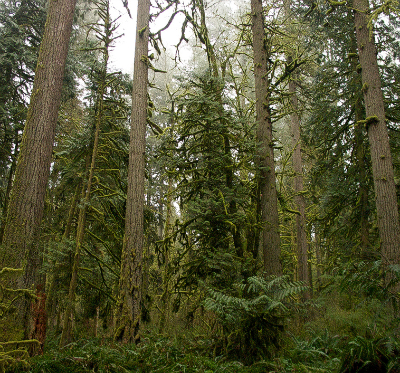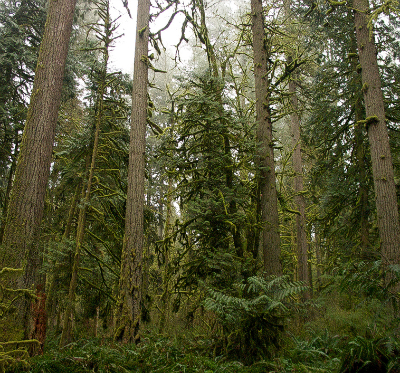 Owners of forestland in the Pacific NW could benefit more under a national carbon offsets system, as trees common to the region store more carbon per acre than East Coast species. Pictured: Douglas firs in an Oregon forest.Courtesy Ecotrust’s sbeebe via FlickrThough most people probably think of national parks when they think of forests, more than half of the 750 million acres of forestland in the United States is actually privately owned, much of it by individuals and families, according to the American Forest Foundation, a nonprofit advocacy organization.
Owners of forestland in the Pacific NW could benefit more under a national carbon offsets system, as trees common to the region store more carbon per acre than East Coast species. Pictured: Douglas firs in an Oregon forest.Courtesy Ecotrust’s sbeebe via FlickrThough most people probably think of national parks when they think of forests, more than half of the 750 million acres of forestland in the United States is actually privately owned, much of it by individuals and families, according to the American Forest Foundation, a nonprofit advocacy organization.
Together, these trees suck up about 10 percent of U.S. carbon dioxide emissions annually, according to the Environmental Protection Agency, a portion that could double to almost 20 percent with increased sustainable management practices like replanting cut trees and lengthening cut rotations.
But many of these family-owned lands are small — a few hundred acres in size. Alone, these small plots don’t sequester much carbon. This makes it difficult for forest owners to participate in voluntary carbon markets, which typically trade carbon by the tens of thousands of tons. In addition, private owners often can’t afford to inventory and verify the amount of carbon sequestered by their forest on their own.
That’s why there’s growing interest in packaging small parcels of forestland into carbon portfolios that can then be traded competitively on voluntary markets.
Woodlands Carbon Company, an Oregon-based pilot project funded by the American Forest Foundation, is just one so-called aggregator looking to pool the carbon trading power of forest owners. It focuses specifically on West Coast clients, who are especially primed to benefit from carbon offsets with lands planted with trees like Douglas Fir and Hemlock Spruce that can sequester more than 1,000 metric tons of CO2 per acre over a 125-year period. Its sister organization, CarbonTree, focuses on the East Coast.
“We bundle all of the smaller woodland owners together so that they can get access to these markets,” says Mike Gaudern, chief executive of Woodlands Carbon. “They wouldn’t have access to these markets unless they had an aggregator to work on their behalf.”
 Special Series: What’s the deal with offsets?Photo illustration by Tom Twigg / GristParticipating in the carbon offset market can be technically challenging, so companies like Woodlands help educate private landowners and foresters through informational workshops that walk potential clients through the many steps of carbon trading. In July, Woodlands hosted two workshops where 120 landowners and foresters came from Oregon, Washington and even California.
Special Series: What’s the deal with offsets?Photo illustration by Tom Twigg / GristParticipating in the carbon offset market can be technically challenging, so companies like Woodlands help educate private landowners and foresters through informational workshops that walk potential clients through the many steps of carbon trading. In July, Woodlands hosted two workshops where 120 landowners and foresters came from Oregon, Washington and even California.
“It was a pretty successful event,” says Gaudern. “There were landowners there that represented close to 60,000 acres of forestland that will be immediately eligible for carbon offset trading.”
In addition, Woodlands offers revolving loans for landowners to complete their carbon inventories, which landowners then pay back through carbon sales.
Woodlands plans to have its first bundle of carbon offsets ready to sell by the end of the fall, most likely either over-the-counter or through the Chicago Climate Exchange (CCX), which requires landowners to sign a contract attesting that the land will be maintained as forest for at least 15 years.
Approximately 9,000 individual farmers, ranchers and forest owners are currently enrolled in CCX, according to Brookly McLaughlin, director of communications for the exchange. Together, they have earned approximately 16.4 million metric tons of offsets since the program’s inception in 2003.
The short-term contracts appeal to Ken Faulk, president of the Oregon Small Woodlands Association, because he believes that the focus should be on reducing carbon emissions in the short term. Faulk owns 155 acres in the Willamette Valley in Oregon and is currently inventorying his forest so he can sell carbon offsets through Woodlands Carbon.
“If people truly believe that we’re going to be on a fossil fuel economy for the next 100 years, then maybe we should be worried about putting carbon away in the trees for a 100-year rotation,” says Faulk. “But I think our goal should be to get the most carbon dioxide out of the atmosphere as soon as we can.”
Clint Bentz, an Oregon family forest landowner and chairman of the Oregon Tree Farm System, also believes short-term contracts are the way to go.
“We think the shorter time frame is not only more palatable to the landowners, it’s also more valuable because it keeps everybody’s attention,” says Bentz. “Keeping everybody’s feet to the fire with these shorter contracts works better with human nature.”
Carbon offsets also provide an additional revenue stream for landowners feeling the squeeze of falling timber prices.
“Nobody’s going to get rich off of carbon offsets, but it’s a real help,” says Bentz. “Recognizing these ecosystem services [like carbon sequestration] is one of the bright lights that we’re seeing to help offset the costs of sustainably managing forests.”
Of course, as long as the price of carbon remains low, many landowners are holding off in the hopes that a national climate law would spur prices.
“For most people who do the math if they’re actually in the sustainable forestry business, they’re going to stay in the timber business and not the carbon business right now,” says Bill Stewart, a forestry specialist at the University of California Cooperative Extension.
Still, some private owners are getting a head start on the offset market now, before carbon legislation is passed. “We see it as trying to get ready to have these offsets available in any future federal legislation and to have the infrastructure in place to make this work for landowners,” says Ted Dodge, executive director of the National Carbon Offset Coalition and Woodlands’ carbon broker.
But not everyone agrees that short-term contracts will best benefit the planet, in part because landowners could clear cut their trees after the contract expires. Ecotrust, an environmental organization based in Portland, Ore., is hoping that any federal legislation for carbon offsets would include strict regulations and long-term contracts similar to the Climate Action Reserve‘s (CAR) protocols, a carbon market that began in California and is now looking to go national.
“Climate Action Reserve’s protocols that are being developed are much more rigorous [than CCX’s] in terms of permanence and additionality,” explains Brent Davies, director of forestry for Ecotrust. Additionality means that the project wouldn’t have happened without carbon offset funds.
For example, CAR’s standards require that forest owners agree to a permanent conservation easement, a legal agreement that requires owners to permanently give up land development rights. But since many private owners aren’t willing to make that commitment, CAR is considering substituting the conservation easement requirement for a 100-year contract.
“We found that the 100-year contract is more acceptable to private landowners who don’t want to necessarily bind their great, great grandchildren to this requirement,” explains Gary Gero, president of CAR. The California Air Resources Board will vote on the new draft in September.
David Eisler, a landowner in the coast range of Oregon, is looking for the sort of long-term contract that CAR offers because he wants to guarantee that his forest stewardship practices will continue after he passes. He is working with Ecotrust on carbon credit possibilities for his property, an 80-acre tract of land that serves as habitat for spotted owls and endangered coho salmon.
“Our efforts to really protect some of this high quality forestland and ancient trees could be gone in a blink once the property changes hands,” says Eisler. “That’s why I’m looking for a conservation easement, but I’m also looking to carbon credits to commit to very long term forest stand.”
Peter Hayes, a landowner who manages about 800 acres in the Northern Oregon Coast Range, is also looking to sell carbon credits on a long-term basis, but says he has yet to find a carbon offset project that fully meets his family’s stringent conservation goals.
“Our approach is to be eagerly involved in understanding and following what’s going on, but constructively skeptical and critical before we choose to commit our land long term,” says Hayes.
Because opinions on carbon offsets are akin to the number of leaves on a branch, one solution may be to include a broad range of options for carbon offsets in the new carbon legislation. By casting a wide net, more people will be able to participate, which will therefore bring in the largest amount of carbon.
“I don’t think it should be either/or situation,” says David Ford, executive director of the Oregon Small Woodlands Association. “We have a rather large problem. We’re not going to solve it with a narrow solution.”



